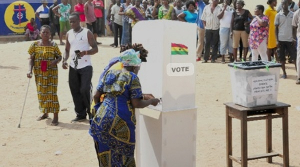Health News of Thursday, 22 March 2007
Source: GNA
Reducing Malaria Deaths Among Children In Rural Ghana
Artesunate-Amodiaquine Home Management Approach
Kumasi, March 21, GNA - Malaria has been identified as the most common but deadly disease in the world. Every day thousands of people, especially pregnant women and children under five years die from malaria.
It is estimated that between 1.1 million and 2.7 million people die of malaria every year. About 3.2 million people in 107 countries are said to live in malaria endemic areas while an estimated 350 million to 500 million clinical malaria episodes occurred annually in the world. The pathetic situation is that, over 90 per cent of this occurs in Sub-Saharan Africa and 70 per cent of the dead are children under five years.
Africa has the greatest burden of malaria cases and deaths in the world with malaria-related maternal anaemia in pregnancy; low birth weight and premature delivery estimated to cause 75,000 to 200,000 infant deaths per year in Africa South of the Sahara. In 2004 malaria caused 18 per cent of deaths of children under five in Sub-Saharan Africa.
In Ghana, malaria is endemic everywhere and it is one of the leading causes of morbidity and mortality, especially among pregnant women and children under five.
Over the past 10 years there have been two million to three million cases of malaria each year, representing 45 per cent of out-patients cases and 33 per cent to 36 per cent of in-patient cases with 36 per cent to 40 per cent OPD malaria cases are in children under five. It is estimated that, in Ghana, every hour four persons die out of malaria. Two of the four are children under five. This means about 35,040 deaths are caused by malaria every year in Ghana. Out of this, 17,520, representing about 25 per cent are children under five years. Mosquito bites have been identified as the main cause of malaria. Over the years governments all over the world have tried in vain to prevent the breeding of mosquitoes and the subsequent transmission of malaria. This had been attributed to the inability of the people, especially those in the Sub-Saharan Africa, to change their attitudes and lifestyles towards the environment.
Choked gutters, stagnant waters, bushy surroundings, heaps of refuse among other things are common sights in cities and towns everyday. This has made malaria prevention and control very difficult. Various drugs and therapies have been developed over the years by doctors and researchers to control and manage malaria infections but the menace persists.
In Ghana for instance, Chloroquine had over the years been used to treat uncomplicated malaria. However, the steady resistance of the malaria parasite to the drug and the reported side effects, such as itching of the body after taking the drug compelled the Ministry of Health to research, develop and introduce new drug, Artesunate-Amodiaquine, which was a combination of two drugs, to be taken on a course.
After few years of its introduction, the drug also came under severe criticism following complaints of the severity of the side effects. It was in the midst of these confusions that the Department of Community Health of the School of Medical Sciences of the Kwame Nkrumah University of Science and Technology (KNUST), Kumasi, decided to undertake a research to determine the efficacy and effectiveness of the Artesunate-Amodiaquine in the treatment of malaria in children under five in rural communities.
The objective of the Home Management of Childhood Malaria (HMM) using Artesunate-Amodiaquine pre-packs was to assess the feasibility; acceptability; safety and cost of using the drug for home management of malaria in young people in the research areas. It had been conducted in the Gomoa, Wa and the Ejisu-Juaben Districts. In the Ejisu-Juaben District, the research was conducted in 35 rural communities in the Juaben and Bomfa Sub-Districts where access to formal health services were limited. It was started in January 2005 and ended in August 2006.
Unit-dose blister packs (pre-packs) of Artesunate-Amodiaquine were given to respectable and gainfully employed individuals in the communities, popularly called Community Drugs Distributors (CDDs) to be distributed to mothers or caregivers to administer to children aged six months to 60 months who had uncomplicated malaria.
The research findings, which was disseminated at a workshop attended by District Directors of Health Services in Ashanti; Chiefs; Assembly Members; Health Workers and Community Health Volunteers as well as other community leaders revealed that, 72 per cent of mothers gave their children, who had fever pre-packed Artesunate-Amodiaquine, with three quarters of them using the drugs appropriately and completing the three-day course.
Ninety Nine per cent of mothers in the research communities found the treatment highly effective for childhood malaria. According to the findings, less than two per cent of the children treated with the drug reported side effects in the form of itching, vomiting and weakness.
The Report indicated that 72 per cent of mothers could tell the correct prescription as given by the CDDs, while 70 per cent of mothers complied fully with instructions given by the CDDs.
Sixty per cent of the respondents sought early treatment for children with fever within 24 hours of onset of symptoms of malaria, while the CDDs provided the correct prescription in 99 per cent of cases of fever treated.
According to Dr E. Nii Laryea Browne, Head of the Department of Community Health of KNUST and Leader of the Research Team, the findings of the Study provided firm and conclusive evidence that pre-packed Artesunate-Amodiaquine was a safe, acceptable and effective drug for home management of Malaria in home and near-home settings in rural communities with poor or limited access to formal health services. He indicated that, doubts about the use of the drug in home management of malaria had been erased from the communities while the method had helped to reduce the travelling time and cost in accessing health care delivery since it was easily available on demand and also non-discriminatory.
It is important to note that, malaria, as indicated earlier continues to be the number one killer of children and pregnant women in the country and every effort by scientists and researchers, which promotes quick response and effective treatment methods must be accepted and adopted into the national health care delivery system. It is in the light of this that the appeal by Dr Browne to all stakeholders in the Health Sector, especially that of young children, to accept and adopt the research findings nationwide is worth supporting. There is the need for all stakeholders to mobilize the relevant political will and financial resources to ensure the rapid scaling up of the home management of malaria strategy across all rural communities in Ghana, using pre-packed Artesunate-Amodiaquine in order to reduce malaria deaths among children in the country.
District Assemblies, District Health Management Teams, Opinion Leaders and Traditional Authorities should accept this all important challenge of dealing with the malaria menace in collaboration with the district-wide mutual health insurance schemes.
This is because the method of treatment is cheaper and would help to reduce the cost of medical care in the communities and thereby reduce the burden of mutual health insurance schemes paying huge medical bills of subscribers to service providers.
As pointed out by Dr Browne, HMM strategy should be combined with the existing malaria control strategies and executed in the context of community integrated management of childhood illness.
The use of Artesunate-Amodiaquine for home management of presumptive malaria in rural Ghana, as revealed by the research findings, is feasible, acceptable and safe and should, therefore, be embraced by all to help to reduce malaria related deaths, especially among children in the country. 21 March 07










